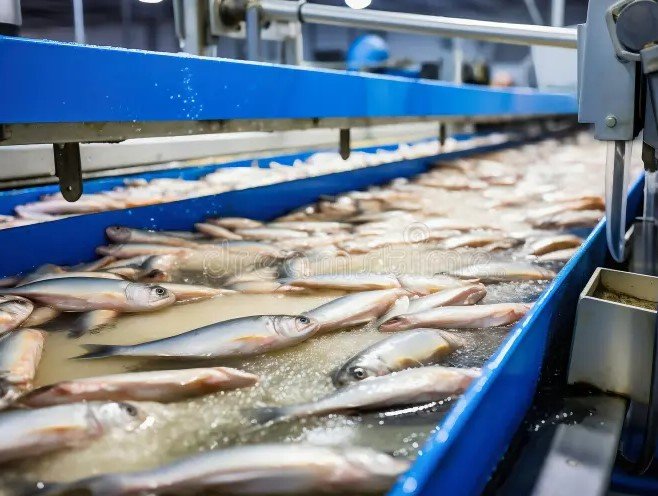Entrepreneurs eager to tap into the booming seafood market can now launch a fish processing business with low capital and minimal risks, thanks to smart strategies like using refurbished equipment and focusing on local niches. As of October 2025, with the global seafood industry projected to hit $210 billion by 2030, driven by rising demand for sustainable protein, small-scale operators are finding ways to enter without massive investments.
Why Now Is Prime Time for Fish Processing Startups
The seafood sector is growing fast. Recent reports show that consumer demand for processed fish products, such as fillets and smoked varieties, has surged due to health trends and convenience needs. In 2025, the industry faces supply chain pressures from climate changes and overfishing, creating openings for agile small businesses that can process local catches efficiently.
This growth comes with opportunities for low-entry players. For instance, in regions like Nigeria and parts of Asia, entrepreneurs are starting small by buying from local fishermen and reselling processed goods, turning modest setups into profitable ventures within months. Experts note that with careful planning, startups can achieve returns in as little as six months, especially in areas with high seafood consumption.
However, timing matters. Current economic conditions, including fluctuating fuel prices for fishing fleets, make it essential to start during stable seasons. By aligning with trends like sustainable sourcing, new entrants can build trust and secure steady buyers.
Key Steps to Launch with Low Capital
Getting started does not require a fortune. Focus on essentials like basic tools and local suppliers to keep costs down. Many successful operators begin in small spaces, such as converted garages or rented facilities, scaling up as revenue flows in.
First, research your market. Identify demand for specific products, like dried or smoked fish, which have longer shelf lives and lower spoilage risks. Then, source affordable equipment. Options include second-hand machines that cost a fraction of new ones, allowing you to process without heavy loans.

Secure necessary permits early. Regulations on hygiene and safety are strict, but complying from the start avoids fines and builds credibility. Finally, partner with local fishers for fresh supplies, cutting transport costs and ensuring quality.
- Define your supply chain: Buy directly from nearby fishermen to reduce expenses.
- Choose value-added processing: Focus on simple tasks like filleting or packaging to boost profit margins.
- Start small: Begin with 500 to 1,000 kg batches to test the market without overcommitting.
Managing Risks in Fish Processing
Risks like spoilage and price swings can derail new businesses, but smart tactics minimize them. Seasonality is a big factor, so plan for off-peak times by diversifying products or storing inventory properly.
Build a reliable cold chain on a budget using insulated coolers and basic freezers. This prevents losses from delays. Also, monitor market prices through apps and local networks to avoid buying high and selling low.
Insurance is key. Affordable policies cover equipment breakdowns and product liability, protecting your investment. Networking with other processors can provide tips on navigating regulations and finding deals.
In practice, many startups reduce risks by starting in low-competition niches, such as organic or ready-to-eat fish items. This approach has helped businesses in rural areas thrive despite economic uncertainties.
| Risk Factor | Mitigation Strategy | Estimated Cost Savings |
|---|---|---|
| Spoilage | Invest in basic refrigeration | Up to 30% on waste reduction |
| Price Fluctuations | Use forward contracts with suppliers | 15-20% on input costs |
| Regulatory Fines | Early compliance training | Avoids penalties up to $10,000 |
| Supply Shortages | Diversify suppliers | Reduces downtime by 40% |
Affordable Equipment and Setup Options
Equipment is often the biggest hurdle, but refurbished options make it feasible. Companies worldwide offer rebuilt filleting machines and freezers at half the price of new ones, complete with warranties for peace of mind.
For a minimal setup, aim for essentials like cutting tables, scales, and packaging tools. Total startup costs can stay under $20,000, based on recent industry averages for small plants. This includes leasing space and basic utilities.
Look into government grants or low-interest loans for agribusiness in many countries, which can cover initial purchases. Real-world examples show processors in Europe and Africa launching with such gear, quickly reaching profitability.
Innovations like DIY ponds or simple smoking kilns further cut costs. These allow you to process without advanced tech, focusing on high-demand items like dried catfish.
Marketing and Scaling Your Operation
Once set up, marketing drives growth. Target local restaurants, markets, and online platforms for quick sales. Social media helps showcase your products, emphasizing freshness and sustainability to attract buyers.
Scale gradually by reinvesting profits. Many operators expand from home-based to small factories within a year, adding staff as orders increase. Track finances closely to spot opportunities, like exporting to nearby regions.
Success stories abound. In Nigeria, low-capital fish businesses have turned into steady income sources by focusing on bulk buying and direct sales. Similarly, in the US, niche processors are capitalizing on eco-friendly trends.
Real-World Success and Future Outlook
Entrepreneurs worldwide are proving that low-capital fish processing works. One operator in East Africa started with a $5,000 investment, using local ponds and basic tools to produce 10 tons annually, yielding strong profits through retail partnerships.
Looking ahead, the industry eyes sustainable practices amid environmental concerns. By 2030, experts predict a shift toward eco-friendly processing, rewarding businesses that adapt early. This creates lasting opportunities for budget-conscious starters.
What do you think about starting a fish processing business? Share your thoughts in the comments and spread this article to help fellow entrepreneurs.








